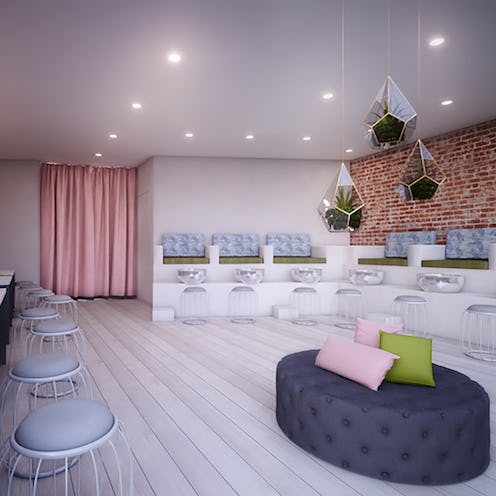Last year, The New York Times published an exposé on unethical practices and poor health conditions of many nail salons, leaving mani and pedi lovers shaking in their shoes. The article sparked national outrage among manicurists and salon owners alike, some of whom have continued to protest the Times as recently as this week. On a positive note, customers are now taking a lot more precautions when it comes to choosing nail professionals. Believe it or not, there are red flags to look out for, questions to be asked and regulations that must be adhered to in order to ensure a safe and healthy salon trip. We discussed the matter with Ruth Kallens, founder of health-conscious nail salon Van Court Studio in New York City. Here, she gives us the breakdown on how to ensure that your pampering break doesn’t take a dangerous turn.
Signs That Your Salon Is Safe
While maintaining a clean appearance is certainly important, plenty of other factors are required in order to deem a nail salon safe. According to Ruth, visible air-ventilation pipes are essential. “In New York, Governor Cuomo is making it mandatory for all nail salons to have ventilation to protect nail technicians and clients,” she says. Other states will hopefully follow suit, and you can read more about the new law here. “Nail technicians should be wearing latex gloves as protection from transferring disease and fungus,” says Ruth, “and they should be using non-metal implements and tools.” If tools cannot be sterilized in a salon’s autoclave (a heated container that uses high pressure and temperature to clean tools), then they should be disposable. “This includes nail files, buffers and orangewood sticks,” she says. Lastly, pedicure tubs are often a concern of salon visitors, and they should be. “If a salon has jetless, tankless, pipeless pedicure stations, it’s likely putting health and safety first,” she says. “Because there is no way to properly sanitize the pipes in Jacuzzi jets, I recommend avoiding salons that use them. If you must, ask the tech to not turn the jets on and to use a disposable liner.” Phew.
The Red Flags
“Some salons will proudly display a UV light and Barbicide jar to help convince clients that they’re in a clean nail salon,” says Ruth. This isn’t a practice that should be taken lightly, because it could actually be a sign that tools aren’t properly sterilized. “If technicians are placing these sanitizing methods in plain sight, they likely don’t sterilize with an autoclave, which is essential to preventing disease and fungus transfer.” States don’t mandate the presence of autoclaves in salons, so some may fail to use them. And some chemicals and products shouldn’t be present in a salon at all. “Certain acrylics such as MMA [methyl methacrylate] are banned in the United States,” Ruth says. Naturally, salons have a ton of chemicals and fumes present in their environment, but they shouldn’t be harmful ones. “A number of the harsh chemicals in nail salons are from toxin-laden nail polishes,” she explains. “There is no reason why salons should use lacquers that aren’t five-free. A number of high-quality brands produce long-lasting, healthier alternatives.”
Questions to Ask Your Nail Technician
As a paying customer, you shouldn’t be intimidated by asking your manicurist questions. If you see something you’re curious about, speak up. Technicians who are willing to discuss the matter are a great representation of an ethical workplace. Ruth suggests questioning how the salon disinfects tools and how it sanitizes pedicure bowls. It should have a medical-grade autoclave for any reusable tools and medical-grade cleaners for pedicure bowls. Ask about the overall treatment process, and be forthcoming with any information regarding your own health. Trained technicians will be aware of any ingredients that may double as allergens. It’s also very important to inform a salon if you have diabetes. “Manicurists should be super sensitive to this intel,” says Ruth. “Diabetics cannot be cut or nicked.”
How Safe Salons Set Themselves Apart
Ruth is the owner of one of New York City’s healthiest nail salons, and she’s determined to put the health of her customers and employees first: “We will not service clients with any foot diseases or fungi, including athlete’s foot or toenail fungus. If we service one client with nail fungus, salons get a bad reputation for spread.” As for tools, Ruth sticks to disposable items and her trusty autoclave. “We use one-time-only foot files, and the stainless steel handle is sterilized via the autoclave,” she says. In the age of gel manicures and acrylics, Ruth sticks to safer options. “We do not offer gel, shellac or acrylics. The toxins are extremely harmful to both techs and clients,” she explains. The polishes they do use are extremely safe. “We offer exclusively five-free or higher nail-lacquer brands owned by female entrepreneurs.”
Tips For a Safer Experience
Communication is key. “Ask to speak to the manager and inquire about red flags,” says Ruth. “If you don’t feel comfortable with the response, don’t frequent that business.” And it’s always a good idea to bring your own kit. “Anything that can touch skin should be included,” says Ruth, including base and top coats, varnish, file, nippers, cuticle pusher, cuticle remover and cuticle oil—or anything else with a dropper. This ensures no cross-contamination.
